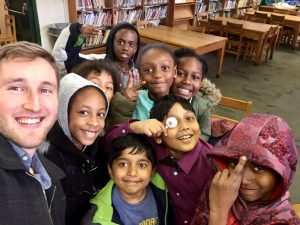From the Archives | In Pursuit of Perfection: Lessons from 4th Graders on Flexibility and Improvisation
In Pursuit of Perfection: Lessons from 4th Graders on Flexibility and Improvisation
Caleb Wiebe – ArtistYear Class of 2017
Right from the start, ArtistYear tested my ability to be flexible. I was surprised to be placed in West Philadelphia’s Powel Elementary School where teaching trumpet or other brass instruments––what I’ve spent years studying––wasn’t an option. My years of conservatory training had prepared me to play Beethoven or Mahler symphonies, I thought, and not to teach recorder classes to eight-year-olds! Still, I entered the year with an open mind, and I quickly realized that I actually had a lot to offer these young, energetic students, and vice versa.

At the start of the school year, I began teaching recorder classes to sixty second, third, and fourth graders, in groups of ten. I approached my lesson planning in my opening months the same way conservatory had conditioned me to approach music––with the aim for perfection. Even though all of my incredible past teachers would agree perfection is not the ultimate goal, my years in intense conservatory environments had trained me to strive for perfection. So at the beginning of the year, I prepared every detail of the lessons, spending a substantial amount of time considering every moment from the time students entered the classroom to when we walked back to their homeroom. I noticed very quickly, however, just how rarely a class went exactly according to plan. I realized that without adopting a more flexible approach, it was going to be an overly stressful year and that I might miss the impact I was striving for.
By being flexible, I spent less time working to make my “perfect” plan fit the students, and instead allowed myself to read the vibe of the class and take the lesson in a different direction, if need be. One day in the middle of a 4th grade class it became apparent that the drudgery of practicing the classic song, “It’s Raining, It’s Pouring,” was just not going to happen. I tried spicing up the process by inserting some new musical techniques but it was of no use. Instead, I pulled out my phone’s handy metronome and set it to 80 beats per minute. Instantly, students were fascinated with the flashing red light and sound of the beat. I told them everyone had 16 beats to improvise their own song, but there was a catch: they could only play the song on a single note. Although not everyone created a brilliant single note song, they were engaged. Through moments like this, I was able to build closer relationships with my students and increase my patience when lessons didn’t go according to plan.
I’ve thought a lot about how I can take these observations and apply them to my own professional music making. Learning to be flexible in teaching at Powel enabled improvisation in my lessons and closer relationships with the students. Additionally, while I still felt entrenched in my habitual pursuit of musical perfection, my awareness of my rigidity is the first step in remembering to pause and instead choose a similar flexibility that will allow for fresh interpretations and closer relationships with future audiences. One simple way to do this is to allow for more flexibility in the recital tradition by incorporating storytelling and discussions in between pieces. Something as simple as telling the listeners about a connection you make with the music or having them listen for a specific motif can change the relationship between performer and audience member dramatically.
As I finished my service year with my elementary students, I continued to explore how what I’ve learned at Powel will influence my performances. And I do look forward to much more teaching in the future, including students as young as my wonderful Powel Elementary School students!
The above was previously published on www.artistyear.org under the name “In Pursuit of Perfection: Lessons from 4th Graders on Flexibility and Improvisation” in April 2017 and has been edited and revised for clarity.
Caleb Wiebe, a musician with a background in trumpet and brass instruments, served as a Music Resident Teaching Artist (formally known as “Fellow”) during the 2016-2017 school year at Samuel Powel Elementary School in Philadelphia, PA.